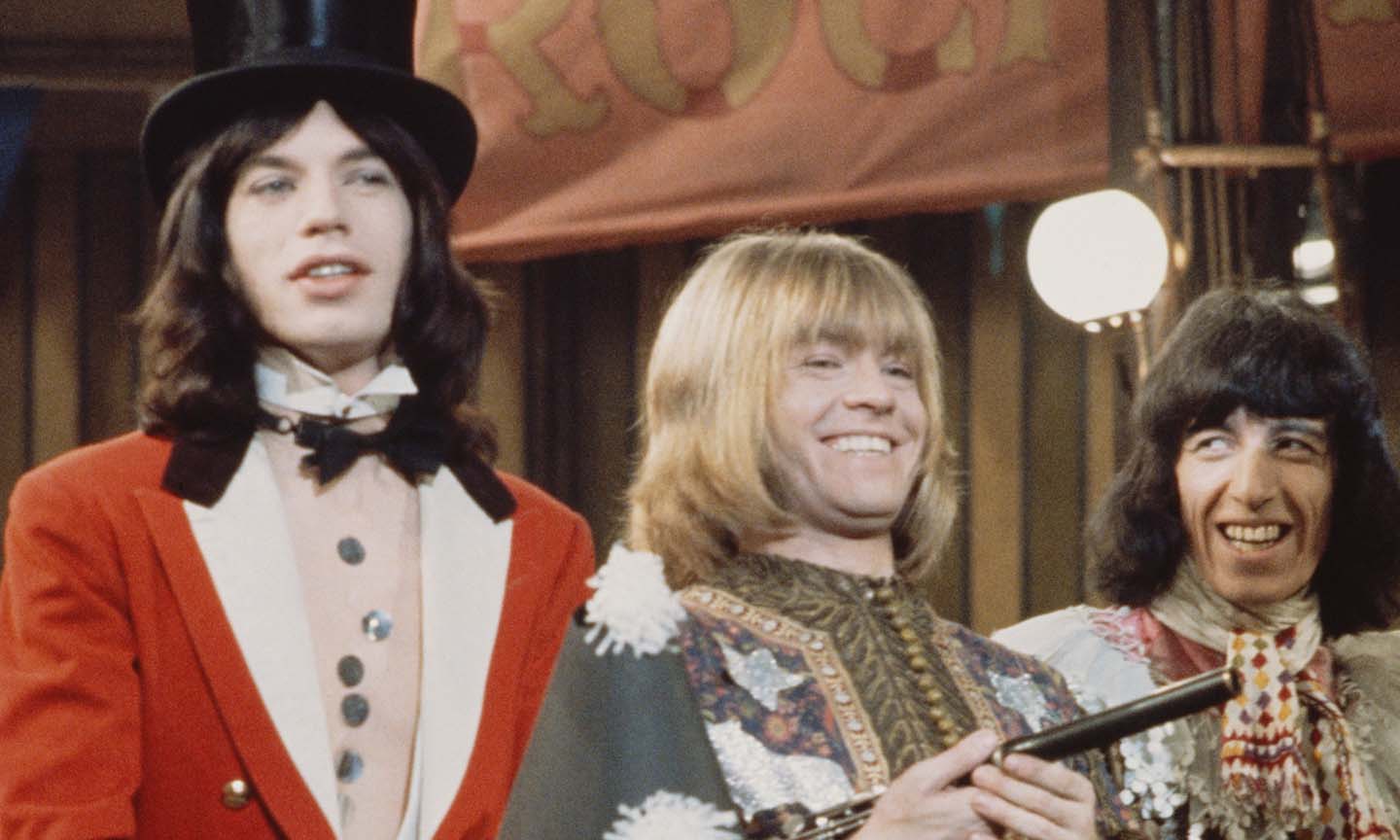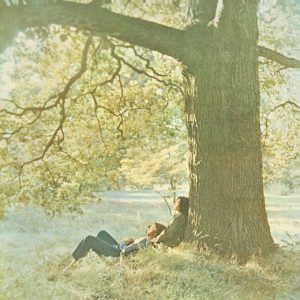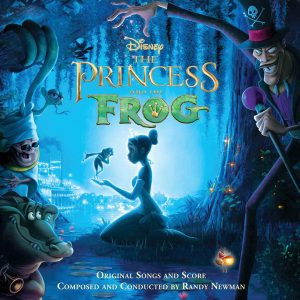Mick Jagger and director Michael Lindsay-Hogg came up with the idea for an all-star music concert filmed under a big-top tent, a project that came to fruition in The Rolling Stones Rock And Roll Circus in December 1968. Footage of the concert, originally intended to be a one-hour BBC television Christmas special, was not shown at the time and was believed lost until a restored version was finally screened in 1996.
Listen to The Rolling Stones Rock And Roll Circus on Apple Music and Spotify.
Lindsay-Hogg earned his reputation as the director of the TV music show Ready Steady Go!, and Jagger was full of praise as they staged the event. “Michael is a very creative guy,” he said. “We came up with this idea, and the whole idea, obviously, is to make it a mixture of different music acts and circus acts, taking it out of the normal and making it slightly surreal… mixing the two up. And also we wanted as many different kinds of music as possible. So that’s why we thought about who would be the best kind of supporting acts.”
The concert was to come in the wake of The Rolling Stones’ Decca album Beggars Banquet, and Jagger and his bandmates wanted to feature leading rock musicians of the day: Traffic and Cream were on the first list of invites, but both had broken up before they could take part. Nevertheless, the list of musicians joining the Stones was impressive: The Who, John Lennon, Yoko Ono, Eric Clapton, Taj Mahal, Jethro Tull, and Marianne Faithfull among them.
Rehearsals and filming
In the days before filming began, on Wednesday, December 11, there were rehearsals and camera tests at three different London venues: the Marquee Club, Olympic Sound Studios, and the Londonderry House Hotel in Mayfair. Some songs were honed and some – including Lennon, Jagger, and Clapton singing a version of Buddy Holly’s “Peggy Sue” – were cut from the final setlist.
Lindsay-Hogg brought in cinematographer Tony Richmond, who went on to film Don’t Look Now with Julie Christie and Donald Sutherland, and The Man Who Fell To Earth, starring David Bowie. To film Rock And Roll Circus he used the latest high-tech French-designed 16mm cameras. The sound was recorded by Glyn Johns and Jimmy Miller, using Olympic’s mobile studio. John McKenna designed many of the costumes.
Filming took place at Stonebridge House in Wembley, at the studios of InterTel video services. The invited audience comprised members of The Rolling Stones’ fan club, the lucky winners of a New Musical Express competition, and a few visiting American Hells Angels.
The stage was designed to resemble the inside of a circus big top, and joining the musicians on the bill were members of Sir Robert Fossett’s Circus, including trapeze artists, fire-eaters, clowns, acrobats, and even a tiger and a boxing kangaroo.
Filming was supposed to be completed in one day, Wednesday, December 11, 1968, but overran, lasting from 2pm until five in the morning on Thursday, December 12. The volume of work involved in setting up stages and re-loading camera film between performances meant that the show ended up lasting more than 15 hours. “The clowns and The Rolling Stones got along very well,” Lindsay-Hogg told The LA Times in March 2019.
“And it was great backstage,” he continued. “They were all sitting in a room – John Lennon, Mick Jagger, Pete Townshend, Eric Clapton – playing blues on guitar and harmonica. Keith Moon was playing spoons on a table.”
The event was spectacular. As well as flamboyant stage outfits, light-hearted banter and classic 60s music – including the only public performance by the supergroup The Dirty Mac (featuring a line-up of Lennon, Richards, and Clapton, plus Jimi Hendrix drummer Mitch Mitchell). There was also a heady atmosphere of drugs and partying among the spectators.
“The Rock And Roll Circus captures the delirious optimism of an era,” said the late music writer David Dalton, who attended the 1968 event.
And it continues to resonate: a newly-digitized version of this unique concert was screened across America in 2019, ahead of a deluxe reissue.
The Rolling Stones Rock And Roll Circus: Who Played And What Happened?
December 11, 1969, 2pm: Mick Jagger’s introduction
At 2pm on December 11, 1968, The Rolling Stones’ frontman, Mick Jagger, wearing a circus ringmaster red costume, bow tie, and top hat, was greeted by cheers as he strode out to deliver the welcome. “You’ve heard of Oxford Circus!” he exclaimed. “You’ve heard of Piccadilly Circus! And this is The Rolling Stones Rock And Roll Circus… and we’ve got sounds and sights and marvels to delight your eyes and ears.”
“Entry Of The Gladiators”/Sir Robert Fossett’s Circus
As Jagger left the stage, a recording of the famous military tune “Entry Of The Gladiators,” written by Czech composer Julius Fučík in 1897, played for about a minute, as members of Sir Robert Fossett’s Circus, including two persons of short stature, Norman McGlen, and Willie Shearer, along with “strongman” Milton Reid, took to the stage.
Jethro Tull
The newly-formed Blackpool rock band Jethro Tull were next. They delivered a rousing version of “A Song For Jeffrey,” with Ian Anderson opening proceedings playing a flute introduction for a song that he had written. Glen Cornic played harmonica, Clive Bunker was on drums and the performance was notable for the guest appearance of Black Sabbath guitarist Tony Iommi, who was briefly standing in for Mick Abrahams. Anderson added to the circus atmosphere, incidentally, by trying to play the flute while standing on one leg – looking as though he was constantly on the verge of a pratfall.
The Who
Stones guitarist Keith Richards introduced The Who by saying, “And now, ladies and gentlemen, dig The Who.” The band – Pete Townshend, Keith Moon, John Entwistle, and Roger Daltrey – were on fine form and performed a playful version of their mini-opera “A Quick One, While He’s Away,” including its mid-song tribute to “Ivor the engine driver.”
“Over The Waves”
The Who were followed by a recording of the popular Mexican waltz “Over The Waves” – which was written in the 19th Century by Juventino Rosas and later recorded as a guitar instrumental by Willie Nelson. “Over The Waves” was used as a 45-second set-filler while circus acts moved scenery.
Taj Mahal
The next big act was American bluesman Taj Mahal, who came on with no introduction. The singer and guitarist was joined by bass player Gary Gilmore, drummer Chuck Blackwell and guitarist Jesse Ed Davis for a spirited version of their recently-recorded song “Ain’t That A Lot Of Love,” which had been written in 1966 by Homer Banks and Willia Dean Parker. Taj Mahal also performed a version of Sonny Boy Williamson’s “Checkin’ Up on My Baby,” but that did not make the final edit.
Marianne Faithfull
The Stones’ drummer Charlie Watts was given the job of introducing singer Marianne Faithfull, who was backed by pre-recorded instrumental tracks as she performed “Something Better,” a ballad written by Gerry Goffin and Barry Mann. Watts introduced Faithfull, who was then Jagger’s girlfriend, as “the beautiful Miss Marianne Faithfull”; the singer, dressed in a floor-length satin gown, held Jagger’s hand as she sang. The Rolling Stones’ frontman had produced her single release of “Something Better.”
Fire-eater and supermodel
Keith Richards introduced the next act, a veteran London fire-eater called Danny Kamara. He was “assisted” by Donyale Luna, an actress who had been the first black model to appear on the cover of British Vogue a couple of years before.
The Dirty Mac
Beatles star John Lennon bantered with Jagger in the introduction to his band’s slot, calling the singer “Nigel” and referring to himself as “Winston Leg-Thigh.” Lennon told Jagger he was about to perform with “your own soul brother, Keith Richards.”
Lennon supposedly came up with the name The Dirty Mac as a play on Fleetwood Mac. His one-off supergroup included Richards on bass, Eric Clapton on lead guitar and Mitch Mitchell, best known for his work in The Jimi Hendrix Experience, on drums. Lennon wore a denim outfit and Mitchell was almost unrecognisable with straight blond hair. They sang the song “Yer Blues’, from The Beatles’ brilliant “White Album”, which had only just come out.
Yoko Ono
Lennon, who also wore a juggler’s outfit with silver sequins and black lace ruffles during the show, then returned to play alongside his partner, Yoko Ono. The singer and artist emerged from a giant black bag dressed as a witch, all in black, with a pointed hat. Yoko’s set was an improvisational jam, with all the members of The Dirty Mac acting as the backing band on a five-minute version of “Whole Lotta Yoko” (also called “Her Blues”). Violin virtuoso Ivry Gitlis played on the 12-bar blues, which was restored for the 1996 film edit.
December 12, 1969, 2am: The Rolling Stones
It was nearly 2am in the morning of December 12 when John Lennon uttered the two words “And now…” to introduce The Rolling Stones, who leapt into a version of “Jumpin’ Jack Flash.” Lennon, who went off to do a BBC radio interview along with Ono, returned for the latter parts of a Stones set that included versions of “Parachute Woman,” “No Expectations” (from Beggars Banquet) and the first ever live filmed performance of “You Can’t Always Get What You Want.”
The set was the final stage appearance of guitarist Brian Jones, who looked dazed as he recreated his dazzling slide guitar lines on “No Expectations.” Though the audience were exhausted after nearly 15 hours at the circus (“The crowd were radically festive by the time the Stones went on,” said Pete Townshend), Jagger stirred them into a frenzy during a version of “Sympathy For The Devil” in which the singer bared his torso and showed off fake tattoos of Lucifer.
The set, which took three hours to complete, ended with an exuberant singalong version of “Salt Of The Earth” with the Stones, who also had Bill Wyman on bass, Nicky Hopkins on piano, and Rocky Dzidzornu playing percussion, going in among the audience to sing and play.




